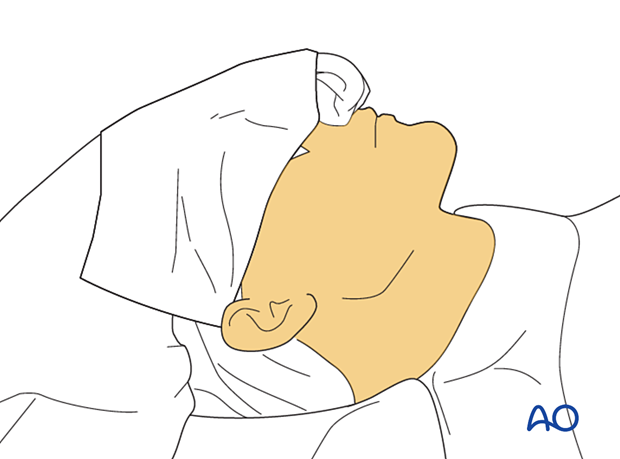Patient preparation
1. Preoperative preparation
Operating room personnel (ORP) need to know and confirm:
- Double check patient's name, birth date and date of imaging
- Details of the patient (including a signed consent form and appropriate antibiotic and thromboprophylaxis)
- Comorbidities, including allergies
- Type of operation planned
- Site and side of the fracture
- Ensure that the surgeon has marked the operative site
- Condition of the soft tissues (fracture: open or closed)
- Implants to be used
- Patient positioning
- Special requirement (eg, blood or blood products)
- Radiographs/ investigations are available and appropriately displayed
Patient positioning
The patient is positioned supine on the operating table.
Pad all pressure points carefully (especially in the elderly).
Ensure there is no metal contact in case monopolar diathermy is used.

A shoulder roll is used to extend the neck and facilitate transcutaneous approaches to the mandible.

Anesthesia
- The procedure is performed under general anesthesia.
- Nasotracheal intubation is preferred to allow MMF during the surgery. If nasotracheal intubation is contraindicated (eg, skull-base fracture, comminuted nasal fractures), discuss with the anesthesiologist regarding alternate methods (eg, submental intubation, retromolar intubation, tracheostomy)
- A local anesthetic with a vasoconstrictor is injected into the surgical areas to achieve a good hemostatic effect. Wait at least 7 to 10 mins for the vasoconstrictor to take effect.
- Antibiotics and steroids are usually administered to prevent infection and reduce swelling.

Skin disinfection and draping
The nasal anesthetic tube is secured in position. The eyes are protected with a bland eye ointment and taped closed.
A throat pack is placed after intubation to prevent fluids from entering the hypopharynx.
Document the throat pack clearly and communicate this to the anesthesia an operating room team.
If postoperative MMF is planned, pass the end of throat pack from retromolar recess to buccal side for ease of retrieval
The entire surgical field is disinfected and draped. If ORIF of the condyles is planned, the ears should be additionally draped into the surgical field. The oral cavity is also prepped.

Operating room setup
Surgeons must have access to the entire head of the patient. The operating room table can be rotated 90-180° depending on the surgeon's preference. Three potential OR setups are illustrated.
















